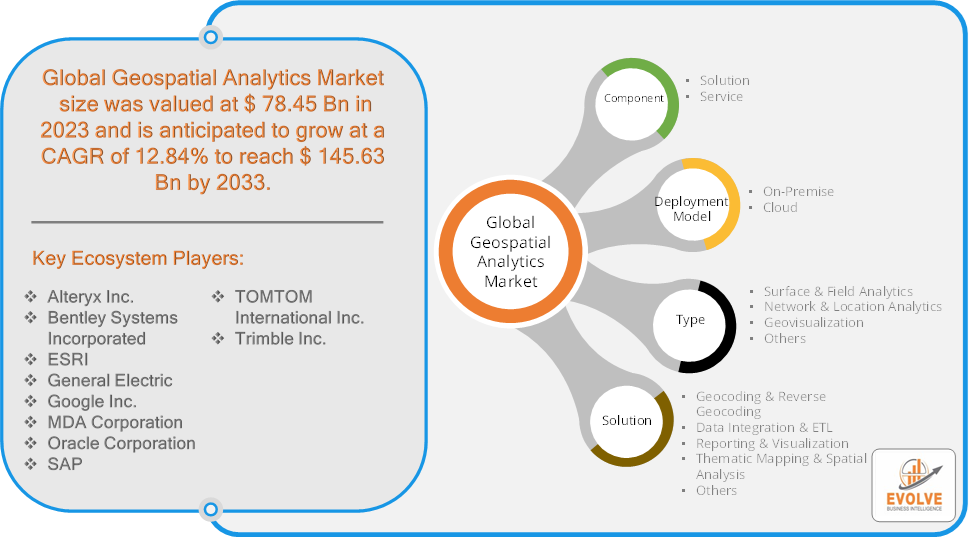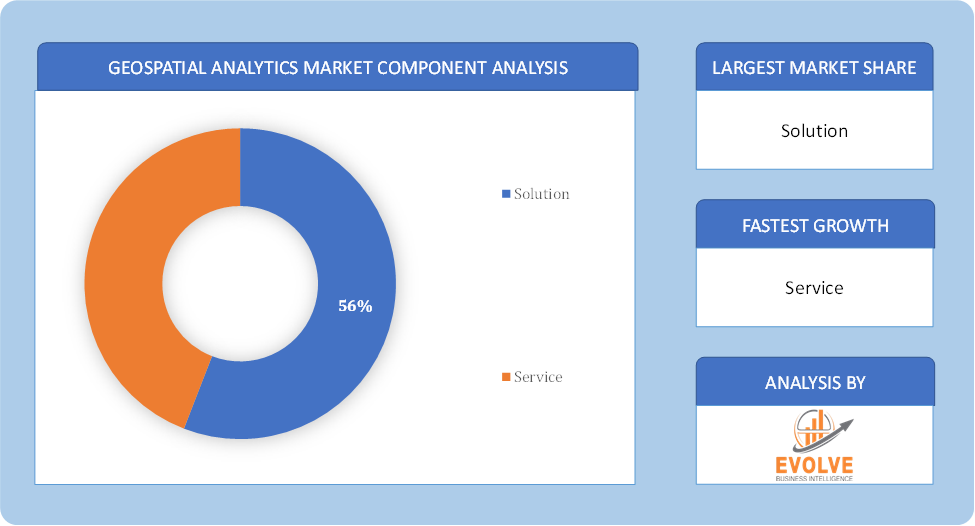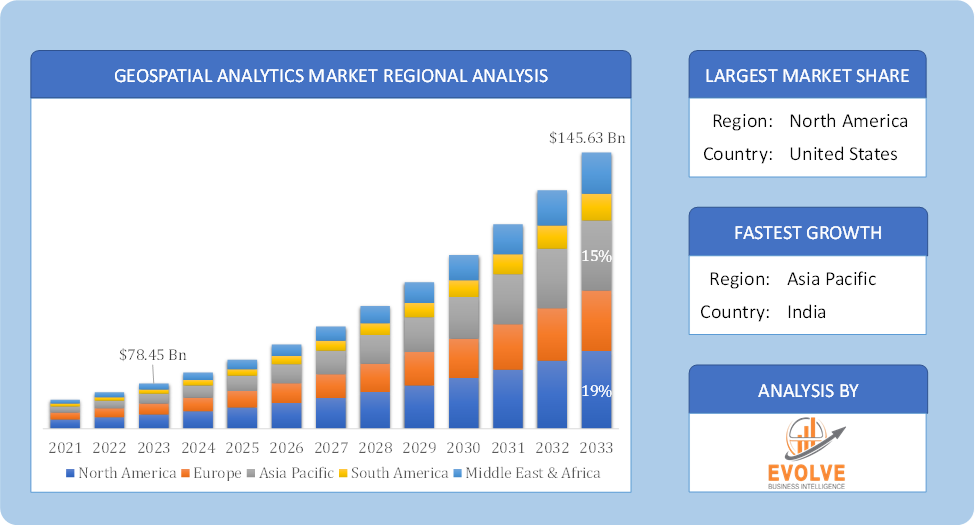Geospatial Analytics Market Overview
The Geospatial Analytics Market Size is expected to reach USD 145.63 Billion by 2033. The Geospatial Analytics Market Solution size accounted for USD 78.45 Billion in 2023 and is expected to expand at a compound annual growth rate (CAGR) of 12.84% from 2023 to 2033. The Geospatial Analytics Market refers to the industry focused on the collection, analysis, and interpretation of data related to the Earth’s surface. This market involves the use of geospatial data, which includes geographic information such as coordinates, boundaries, and physical features, combined with various technologies to analyze patterns, trends, and relationships in a spatial context. Geospatial analytics is used to provide insights into various applications, including urban planning, agriculture, natural resource management, transportation, defense, and environmental monitoring.
The market is driven by advancements in technology, such as artificial intelligence (AI) and big data analytics, as well as the growing demand for location-based services and the need for effective resource management in various sectors.
Global Geospatial Analytics Market Synopsis
The COVID-19 pandemic had a significant impact on the Geospatial Analytics Market. With many industries shifting to remote work, there was an increased reliance on remote sensing technologies and GIS for tasks that traditionally required on-site presence, such as infrastructure monitoring, environmental management, and urban planning. Geospatial analytics played a crucial role in managing healthcare infrastructure by helping to identify areas with higher demand for medical resources, such as hospitals and testing centers. The pandemic accelerated smart city initiatives where geospatial analytics were used to manage public safety, resource allocation, and urban mobility more efficiently, using IoT sensors and data integration platforms. There was an increased focus on using geospatial analytics for public safety applications, such as crowd management, emergency response, and maintaining social order during the pandemic. The pandemic created opportunities for innovation in the geospatial analytics market, particularly in developing new tools and applications for crisis management, predictive modelling, and resource optimization.
Geospatial Analytics Market Dynamics
The major factors that have impacted the growth of Geospatial Analytics Market are as follows:
Drivers:
Ø Technological Advancements in AI and Big Data
The incorporation of AI and machine learning algorithms in geospatial analytics allows for more accurate predictions, pattern recognition, and decision-making. These technologies enable the processing of large datasets and the extraction of actionable insights from complex geospatial data. The ability to process and analyze massive volumes of geospatial data in real-time is critical for applications like smart cities, disaster management, and autonomous vehicles. Big data analytics enhances the capabilities of geospatial tools, making them more powerful and efficient. As cities grow and urbanize, there is a need for efficient planning and management of infrastructure. Geospatial analytics aids in optimizing land use, transportation networks, utilities, and public services, supporting the development of smart cities. Geospatial data is used to analyze traffic patterns, optimize public transportation routes, and improve urban mobility, contributing to more sustainable and efficient cities.
Restraint:
- Perception of Data Privacy and Initial Investment
Geospatial analytics often involves the collection and analysis of sensitive location-based data, including personal and confidential information. Concerns about data privacy, particularly in relation to surveillance and tracking, can limit the adoption of these technologies. The implementation of geospatial analytics requires significant investment in hardware, software, and skilled personnel. High upfront costs can be a deterrent for small and medium-sized enterprises (SMEs) and organizations with limited budgets.
Opportunity:
⮚ Advancements in Artificial Intelligence and Machine Learning
The integration of AI and machine learning with geospatial analytics offers opportunities to develop more advanced and predictive models. These technologies can enhance the accuracy of spatial analysis, automate data processing, and provide real-time insights, driving innovation in the market. The ability to process and analyze geospatial data in real-time is becoming increasingly important for applications such as disaster management, traffic monitoring, and public safety. Companies that can offer real-time geospatial analytics solutions have a significant growth opportunity.
Geospatial Analytics Market Segment Overview
Based on Component, the market is segmented based on Solution and Service. The solution segment dominant the market. The geospatial analytics solution offers robust tools for mapping. It makes them indispensable for urban planning, environmental monitoring, disaster management, etc. For instance, the introduction of advanced geospatial software platforms like Esri’s ArcGIS has revolutionized how organizations collect, visualize, and analyze spatial data.
By Deployment Model
Based on Deployment Model, the market segment has been divided into the On-Premise and Cloud. The cloud segment dominant the market. The cloud-based platform facilitates real-time data access. Moreover, it empowers businesses and governments to harness the power of geospatial analytics with enhanced flexibility, reduced costs, the ability to scale operations dynamically, etc.
By Type
Based on Type, the market segment has been divided into the Surface & Field Analytics, Network & Location Analytics, Geovisualization and Others. The network and location analytics segment dominant the market. The technology aids in the improvement of data analytics’ functionality, utility, and relevance. It can also analyze and organize enormous amounts of data in real time in order to obtain actionable business insights. It also enables marketers to visualize, comprehend, and interpret data in a variety of ways to demonstrate links, trends, and patterns using globes, maps, charts, and reports.
By Solution
Based on Solution, the market segment has been divided into the Geocoding & Reverse Geocoding, Data Integration & ETL, Reporting & Visualization, Thematic Mapping & Spatial Analysis and Others. The thematic mapping and spatial analysis segment dominant the market. Businesses are eager to understand customer behavior and demand trends, which will drive the adoption of these solutions. Thematic mapping and spatial analysis solutions help organizations view, analyze, and interpret spatial data to uncover patterns, trends, and linkages within geographic contexts. Thematic mapping solutions use colors, symbols, and patterns to visually depict spatial data and convey information about specific themes or features, such as population density, land use, or environmental considerations.
Global Geospatial Analytics Market Regional Analysis
Based on region, the global Geospatial Analytics Market has been divided into North America, Europe, Asia-Pacific, the Middle East & Africa, and Latin America. North America is projected to dominate the use of the Geospatial Analytics Market followed by the Asia-Pacific and Europe regions.
 Geospatial Analytics North America Market
Geospatial Analytics North America Market
North America holds a dominant position in the Geospatial Analytics Market. North America, particularly the United States, is a leading region in the geospatial analytics market. The region’s dominance is driven by the presence of major technology companies, significant government investments in defense and public safety, and the widespread adoption of advanced technologies like AI and big data. In North America, geospatial analytics is extensively used in sectors such as defense, homeland security, urban planning, environmental monitoring, and agriculture. The region’s robust infrastructure and focus on smart city initiatives further contribute to market growth.
Geospatial Analytics Asia-Pacific Market
The Asia-Pacific region has indeed emerged as the fastest-growing market for the Geospatial Analytics Market Solution. The Asia-Pacific region is experiencing rapid growth in the geospatial analytics market, driven by economic development, urbanization, and increased government investments in infrastructure and smart city projects. Countries like China, India, Japan, and Australia are key contributors to this growth. The region’s focus on developing smart cities and improving urban infrastructure is a significant driver for the market. Geospatial analytics is used extensively in urban planning, disaster management, and transportation.
Competitive Landscape
The global Geospatial Analytics Market is highly competitive, with numerous players offering a wide range of software solutions. The competitive landscape is characterized by the presence of established companies, as well as emerging startups and niche players. To increase their market position and attract a wide consumer base, the businesses are employing various strategies, such as product launches, and strategic alliances.
Prominent Players:
- Alteryx Inc.
- Bentley Systems Incorporated
- ESRI
- General Electric
- Google Inc.
- MDA Corporation
- Oracle Corporation
- SAP
- TOMTOM International Inc.
- Trimble Inc.
Key Development
In July 2024, CARTO, the cloud-native spatial analysis platform, announced the launch of CARTO AI Agents, which combine geospatial technology with AI.
In July 2024, AiDash unveiled the AI Center of Excellence in Bengaluru, India, to focus on remote sensing and geospatial analytics.
Scope of the Report
Global Geospatial Analytics Market, by Component
- Solution
- Service
Global Geospatial Analytics Market, by Deployment Model
- On-Premise
- Cloud
Global Geospatial Analytics Market, by Type
- Surface & Field Analytics
- Network & Location Analytics
- Geovisualization
- Others
Global Geospatial Analytics Market, by Solution
- Geocoding & Reverse Geocoding
- Data Integration & ETL
- Reporting & Visualization
- Thematic Mapping & Spatial Analysis
- Others
Global Geospatial Analytics Market, by Region
- North America
- US
- Canada
- Mexico
- Europe
- UK
- Germany
- France
- Italy
- Spain
- Benelux
- Nordic
- Rest of Europe
- Asia Pacific
- China
- Japan
- South Korea
- Indonesia
- Austalia
- Malaysia
- India
- Rest of Asia Pacific
- South America
- Brazil
- Argentina
- Rest of South America
- Middle East & Africa
- Saudi Arabia
- UAE
- Egypt
- South Africa
- Rest of Middle East & Africa
| Parameters | Indicators |
|---|---|
| Market Size | 2033: USD 145.63 Billion |
| CAGR (2023-2033) | 12.84% |
| Base year | 2022 |
| Forecast Period | 2023-2033 |
| Historical Data | 2021 (2017 to 2020 On Demand) |
| Report Coverage | Revenue Forecast, Competitive Landscape, Growth Factors, and Trends |
| Key Segmentations | Component, Deployment Model, Type, Solution |
| Geographies Covered | North America, Europe, Asia-Pacific, South America, Middle East, Africa |
| Key Vendors | Alteryx Inc., Bentley Systems Incorporated, ESRI, General Electric, Google Inc., MDA Corporation, Oracle Corporation, SAP, TOMTOM International Inc. and Trimble Inc. |
| Key Market Opportunities | · Advancements in Artificial Intelligence and Machine Learning |
| Key Market Drivers | · Technological Advancements in AI and Big Data · Adoption in Smart Cities and Urban Planning |
REPORT CONTENT BRIEF:
- High-level analysis of the current and future Geospatial Analytics Market trends and opportunities
- Detailed analysis of current market drivers, restraining factors, and opportunities in the future
- Geospatial Analytics Market historical market size for the year 2021, and forecast from 2023 to 2033
- Geospatial Analytics Market share analysis at each product level
- Competitor analysis with detailed insight into its product segment, Government & Defense strength, and strategies adopted.
- Identifies key strategies adopted including product launches and developments, mergers and acquisitions, joint ventures, collaborations, and partnerships as well as funding taken and investment done, among others.
- To identify and understand the various factors involved in the global Geospatial Analytics Market affected by the pandemic
- To provide a detailed insight into the major companies operating in the market. The profiling will include the Government & Defense health of the company’s past 2-3 years with segmental and regional revenue breakup, product Offering, recent developments, SWOT analysis, and key strategies.









